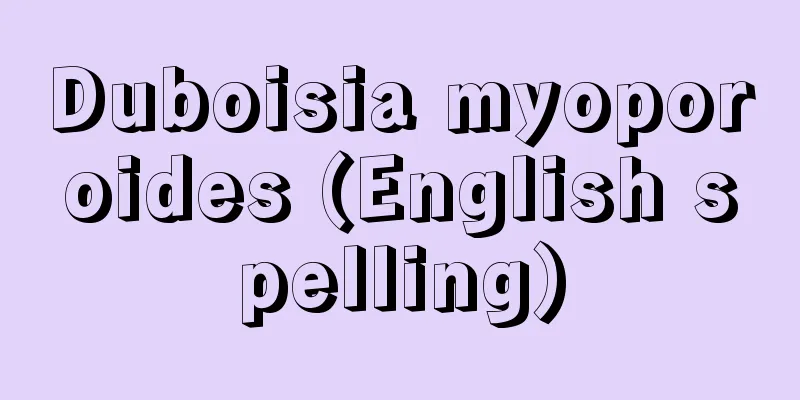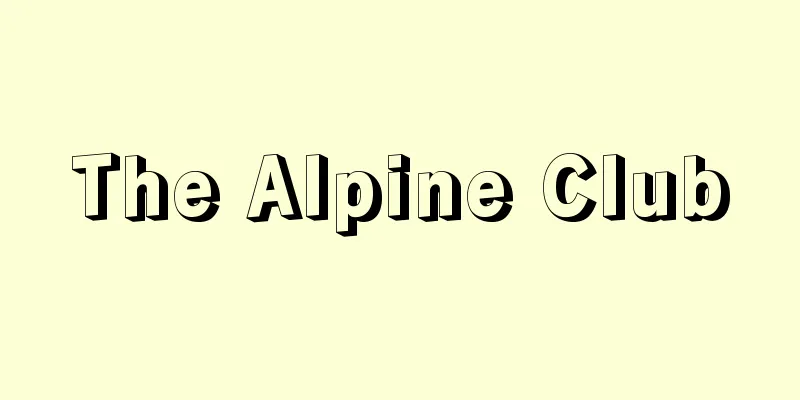Belinskiy - Belinskiy (English notation)

|
Russian critic. Born to a poor country doctor in Chembar, Penza Province (now Belinsky), in 1829, he entered the Faculty of Letters at Moscow University on a national scholarship. He was expelled from the university in 1832 due to criticism of serfdom in his Schiller-esque play Dmitri Kalinin, which he wrote while he was a student. The following year, he was invited by Nadezhdin, critic and editor of Telescope and Molva, to embark on the path of literary criticism. In his debut essay, Literary Fantasies (Molva, 1834), he surveyed the past and present of Russian literature, condemning the absence of true literature in Russia and passionately calling for the emergence of true literature. [Fujiya Soichi] Reconciliation with realityAnother important event in 1833 was his meeting with Stankevich. In the Stankevich circle, Belinsky not only made lifelong friends such as Botkin and Bakunin, but also learned about and became fascinated with German philosophy such as Schelling, Fichte, and Hegel. In particular, from the autumn of 1837 onwards, he became fascinated with Hegelian philosophy through Bakunin, and from the viewpoint that "everything that exists is rational", he endorsed the existing society politically and advocated the supremacy of art aesthetically. This period up to the early 1940s is called the period of "reconciliation with reality" and is considered to be the time of Belinsky's crisis. During this period, he wrote works such as On Hamlet (1838) and On the Day of the Battle of Borodino (1839). [Fujiya Soichi] Towards real changeHowever, his criticism of serfdom and Russian literature that was detached from reality, which he had shown in his first play and his first essay, remained deep within him. In 1839, he was invited to St. Petersburg to take charge of the criticism section of the magazine Miscellany of the Fatherland, and when he learned of Feuerbach's materialistic philosophy through Herzen, this crisis of "reconciliation with reality" was overcome. From then on, he actively engaged in critical activities in search of the path Russia should take and the ideal form of Russian literature. In "The Deeds of Peter the Great, the Insightful Reformer of Russia" (1841), he argued that the modernization of Russia modeled on Western Europe was the path to a humane society and the only way to join the universal civilization of mankind, and thus he adopted a so-called Westernist stance. In "De critique" (1842), he argued that art was also a reflection of the spirit of the times and that criticism of reality should not be lost, and abandoned the idea of art supremacy. In his "On Pushkin," consisting of eleven essays published between 1843 and 1848, he provided a sharp and in-depth analysis of the historical flow of Russian literature and individual writers, emphasizing that Russian literature had passed the Pushkin era and entered a new era, namely the Gogol era and the era of realism. From this perspective, he was one of the first to recognize and highly evaluate Turgenev, Goncharov, Nekrasov, Dostoevsky, and others, proving his keen critical eye. In addition, when Gogol made a statement toward the end of his life that seemed to condone Russia's past and present state (Selected Letters from Friendships, 1847), Belinsky immediately refuted it, fiercely denouncing the current state of Russia, which is built on inhuman serfdom and autocracy (Letters to Gogol, 1847). "An Overview of Russian Literature in 1847," written in the year of his death, can be considered one of Belinsky's representative essays in the sense that it most succinctly expresses his critical methods and aims, which were to view literature from a historical perspective, to defend realist literature that was not detached from reality, and to look forward to a truly national literature. [Fujiya Soichi] "The True Meaning of Art" and "Classification of American Literature" translated by Futabatei Shimei (included in the Complete Works of Futabatei Shimei, Vol. 5, 1965, Iwanami Shoten)" ▽ "Collection of Russian Literary Criticism, translated by Yoshitaro Yomura, two volumes (Iwanami Bunko)" ▽ "Criticism" translated by Yukihiko Kaneko, Letters to Gogol translated by Seiichi Wakuri (included in the Complete Works of World Great Thinkers 27, 1954, Kawade Shobo)" Source: Shogakukan Encyclopedia Nipponica About Encyclopedia Nipponica Information | Legend |
|
ロシアの批評家。ペンザ県チェンバル(現ベリンスキー市)の貧しい田舎(いなか)医師の家に生まれる。1829年に国の奨学生としてモスクワ大学文学部に入学。在学中に書いたシラーばりの戯曲『ドミトリー・カリーニン』の農奴制批判などが災いして、32年大学を追われる。翌33年、批評家であり『テレスコープ』誌・『モルバ』紙の編集者でもあったナデージジンに招かれ、文芸批評の道に踏み出す。デビュー論文「文学的空想」(『モルバ』紙、1834)でロシア文学の過去と現在を概観し、ロシアに真の文学はないと断罪、真の文学の出現を熱烈に訴えた。 [藤家壯一] 現実との和解1833年のもう一つの重要事はスタンケービチとの出会いで、ベリンスキーはこのスタンケービチ・サークルにおいてボトキン、バクーニンなど終生の友を得ただけでなく、シェリング、フィヒテ、ヘーゲルなどのドイツ哲学を知り、熱中した。とくに37年秋以降はバクーニンを通じてヘーゲル哲学に心酔し、「存在するものはすべて合理的である」との観点から、政治的には現存社会を是認し、美学的には芸術至上主義を提唱した。40年代初頭までのこの時期を「現実との和解」の時期といい、ベリンスキーの危機の時代とされる。この時期には『ハムレット論』(1838)、『ボロジノ会戦記念日』(1839)などが書かれている。 [藤家壯一] 現実の変革へしかし処女戯曲やデビュー論文でみせた農奴制批判や、現実から遊離したロシアの亜流ロマン主義文学批判は彼の奥深くに生き続けており、1839年に『祖国雑記』誌の批評部門を担当すべく招かれてペテルブルグに移り住み、ゲルツェンを通してフォイエルバハの唯物論哲学を知るに至って、この「現実との和解」の危機は克服されていった。そしてこれ以後、彼はロシアの進むべき道、ロシア文学のあるべき姿を求めて精力的に評論活動を展開する。『ロシアの明敏なる改造者ピョートル大帝の事蹟(じせき)』(1841)で、西欧をモデルとするロシアの近代化こそが人間的な社会への道であり、人類の普遍文明に加われる唯一の道であると主張して、いわゆる西欧主義の立場にたち、『批評論』(1842)においては、芸術も時代精神の反映であり、現実に対する批判を失ってはならないと説き、芸術至上主義を捨てた。43~48年に発表した11の論文からなる「プーシキン論」ではロシア文学の歴史的な流れと個々の作家についての鋭く深い考察を行い、ロシア文学がプーシキン時代を経て新しい時代、すなわちゴーゴリ時代、リアリズム文学の時代を迎えたことを強調した。この見地から彼は、ツルゲーネフ、ゴンチャロフ、ネクラーソフ、ドストエフスキーなどをいち早く認めて高く評価し、批評眼の確かさを立証している。なお、ゴーゴリが晩年近くにロシアの過去と現状を容認するかのような発言をした(『交友書簡選』1847)ことにベリンスキーはただちに反論し、非人間的な農奴制と専制政治のうえに築かれているロシアの現状を激しく糾弾した(『ゴーゴリへの手紙』1847)。死の年に書かれた『1847年のロシア文学概観』は、歴史的視点から文学をとらえ、現実から遊離しないリアリズム文学を擁護し、真の国民文学を期待するという彼の批評の方法と目的とがもっとも端的に表れているという意味でもベリンスキーの代表論文といえる。 [藤家壯一] 『二葉亭四迷訳『美術の本義』『米氏文辞の類別』(『二葉亭四迷全集 第五巻』所収・1965・岩波書店)』▽『除村吉太郎訳『ロシア文学評論集』全二冊(岩波文庫)』▽『金子幸彦訳『批評論』、和久利誓一訳『ゴーゴリへの手紙』(『世界大思想全集27』所収・1954・河出書房)』 出典 小学館 日本大百科全書(ニッポニカ)日本大百科全書(ニッポニカ)について 情報 | 凡例 |
Recommend
Eastern Marsh Harrier
...A species of bird in the family Accipitridae, ...
Leopold II (Holy Roman Emperor)
The Belgian Revolution was a revival of the Belgi...
Goodyera schlechtendaliana (English spelling) Goodyeraschlechtendaliana
… [Ken Inoue]. … *Some of the terminology that me...
Abolitionist Movement - Abolitionist Movement
The modern movement to abolish slavery began from ...
Kazimir Severinovich Malevich
Russian painter. Born near Kiev, he studied at th...
Haiki Seto
Located in the southern part of Sasebo City, Naga...
Kidd, W.
…British pirate. His real name was William Kidd. ...
Tantra (English spelling)
The sacred texts of the Hindu Shakta sect, which w...
Atlas Coelestis (English spelling)
...Beyer's atlas, published in 1603, was the ...
The Lost World of Kalahari
...This novel was the basis for the film Merry Ch...
Vaccina virus
...It is well known that Jenner developed the vac...
Uji Left Minister
…A nobleman in the late Heian period. He was know...
Two memorial services
The name of a part of a Buddhist ceremony. It is a...
Hominization
Phenomena that have undergone continuous change in...
Copera annulata (English: Copera annulata)
An insect of the family Polytminae (illustration) ...









